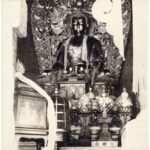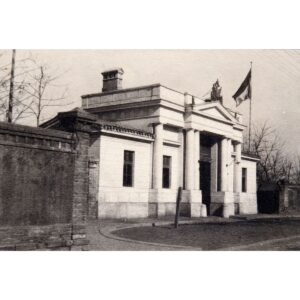Photography Metal Statue of Sakyamuni Buddha at the Yonghe Temple
A black-and-white photograph showing a bronze statue of one of the “Three Buddhas” in Yonghe Hall (Yonghedian 雍和殿) at the Yonghe Gong 雍和宫 or “Temple of Tranquility and Harmony” temple complex in Beijing. The “Three Buddhas” statues in Yonghe Hall are two metres high and represent the past, present, and future. In the photo here we can see the central “Buddha of the Present” – Sakyamuni Buddha. Although the three Buddha statues are almost identical, they can be distinguished by their iconography and mudras. Sakyamuni Buddha holds his hands in the bhumisparshamudra or “Earth Touching Mudra”. It symbolises the Buddha’s enlightenment under the Bodhi tree when he invoked the Earth goddess Sthavara to witness his enlightenment. Behind the statue, there is a pedestal in the shape of a lotus flower – a symbol of purity. Incense burners, candlesticks, flower vases, and cloisonné enamelware are placed in front of ... more
A black-and-white photograph showing a bronze statue of one of the “Three Buddhas” in Yonghe Hall (Yonghedian 雍和殿) at the Yonghe Gong 雍和宫 or “Temple of Tranquility and Harmony” temple complex in Beijing. The “Three Buddhas” statues in Yonghe Hall are two metres high and represent the past, present, and future. In the photo here we can see the central “Buddha of the Present” – Sakyamuni Buddha. Although the three Buddha statues are almost identical, they can be distinguished by their iconography and mudras. Sakyamuni Buddha holds his hands in the bhumisparshamudra or “Earth Touching Mudra”. It symbolises the Buddha’s enlightenment under the Bodhi tree when he invoked the Earth goddess Sthavara to witness his enlightenment. Behind the statue, there is a pedestal in the shape of a lotus flower – a symbol of purity. Incense burners, candlesticks, flower vases, and cloisonné enamelware are placed in front of the statue.
The Manchu rulers promoted Tibetan Buddhism (or Lamaism) and encouraged the visits of high religious dignitaries and the construction of numerous Tibetan temples in and around Beijing.
The photograph is the 198th of 449 photographs of Beijing and its surroundings in the album of Ivan Skušek Jr., purchased during his stay in Beijing (1914–1920). In the handwritten inventory of the album, the photograph is referred to as Lama-Kloster: Götze (Metall). (DZ, MV)



































Do you have a comment or additional information about the subject?